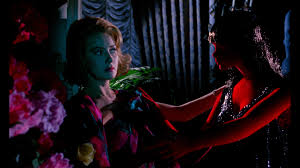 Strange that I've rarely cottoned to Mario Bava's horror films. One can respect his exorbitant style and genre innovations, yet for me he's always been a poor second to his protégé Dario Argento. Blood and Black Lace (1964) is a prime example, beautiful to behold but unconvincing in its content.
Strange that I've rarely cottoned to Mario Bava's horror films. One can respect his exorbitant style and genre innovations, yet for me he's always been a poor second to his protégé Dario Argento. Blood and Black Lace (1964) is a prime example, beautiful to behold but unconvincing in its content.A murderer targets supermodels at a salon in Rome. Police naturally suspect the salon's proprietors, Massimo Morlacchi (Cameron Mitchell) and Contessa Cristina Como (Eva Bartok), but the evidence doesn't add up. Investigation reveals a tangle of drug abuse and sexual liaisons that the killers, whoever they are, seem desperate to cover up.
Perhaps the earliest true giallo, Blood and Black Lace is as much whodunit as slasher movie. Bava presents a silly Agatha Christie-style plot that doesn't hang together, where everyone appears to have a motive. The problem is, it's really hard to care: the models are interchangeable tarts and ditzes, the men losers or petty criminals ensnared in sundry shadiness. Like Bava's later Bay of Blood, it degenerates into a kill-off featuring boring or reprehensible characters we couldn't care less about.
Even higher-end slasher flicks suffer from sadism and misogyny, their only cleverness expressed in garish murders. Bava's an especially bad offender: the killer has a silly predilection to topple objects (including suits of armor) onto his victims, with brutal strangulations and scalding with red-hot lamps. Despite Bava's flourishes (I enjoyed the blood flooding into a corpse-filled bathtub), the off-putting nastiness remains. Bava's legions of imitators abandoned his pretenses to class, boring in solely on improbable deaths.
That, I suppose, is what sets Blood and Black Lace apart from its successors. His pied color schemes and elaborate art direction emphasizes primary colors, from blinking green signs and glowering to a dangling red phone. His sumptuous long takes and jarring close-ups make for an effective exercise in direction, if nothing else. The best is a brilliant murder scene where one model's stalked through an antique store basement, filmed nearly silent as the killer entraps his victim.
Unfortunately, Bava underscores too many scenes with Carlo Rustichelli's lush jazz score, which seems incongruous when paired with grisly eviscerations. There's a clever misdirection late in the movie that amounts to little, as we're treated to a long scene where the killers explain their scheme in laborious detail. Eventually they turn on each other, resulting in a singularly unsatisfying climax.
It's questionable whether Argento, Fulci or other giallo directors had better craftsmanship than Mario Bava, who preceded and directly mentored many of them. Still, their works generally seem more satisfying and complete. So it goes - you can't please Groggy all the time.

